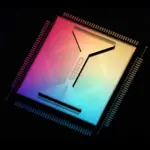
Fujitsu plans 2nm AI successor to Fugaku supercomputer chip
Fujitsu is aiming to take back the top supercomputer slot with a 2nm ARM-based chip for the successor to the Fugaku supercomputer.
The Fujitsu-Monaka chip uses the ARM v9-A architecture with the Scalable Vector Extension 2 (SVE2) extensions for machine learning and AI workloads.
This aims to use a 3D any-to-any interconnect for a ‘many core’ architecture and microarchitecture enhancements to double the performance of the chip and double the energy efficiency of a supercomputer system compared to the previous 48 core A64FX chip (shown below).
Fugaku has been the world’s most energy efficient and highest performing supercomputer, based on the A64FX CPU. This ARMv8 design was the first to use the first generation SVE extensions and has a performance of 2.7TFLOPS when the 8.7bn transistor device was taped out in 2018 on a 7nm process.
Doubling the performance would put Monaka at 5.4TFLOPS for the same, unspecified, power consumption. While the performance improvement is possible from the process scaling, the major challenge is maintaining the power consumption at 2nm.
The chip is expected to use an enhancement of Fujitsu’s Tohu proprietary network on chip (NoC) ring-based interconnect.
“By using the widely adopted Armv9-A architecture, Fujitsu and Arm aim to work towards enabling developers to easily port and optimize their applications towards expanding the AI ecosystem and make it more accessible and affordable for various users and industries,” said Fujitsu.
Training AI models and systems places considerable demands on the underlying hardware, thus increasing energy consumption. Inefficient hardware support for running complex AI workloads not only impacts energy efficiency but also performance. One way to achieve this is build an underlying architecture and technology stack for data centres, enabling organizations to achieve the best performance with low energy consumption.
This laid the foundation for ARM to develop the SVE2 architecture, but requires close cooperation with the software team in India to ensure compatibility.
“Fujitsu has a strong legacy of contributing towards the Arm ecosystem and we have extensively contributed towards building the ARM software stack,” said Dr. Priyanka Sharma, Director of Software Engineering at Fujitsu Research of India, who is leading the Monaka Software R&D Unit.
”Through Fujitsu-Maonaka, we are committed to taking our association further to push our developments in the high-performance computing domain to the open source community and work towards building a unified development ecosystem that plays a vital role in advancing the creation of cross-platform software and accelerators,”
“The Monaka HPC R&D Unit in India is actively collaborating with the Arm team towards co-development of various software level enablement/tuning efforts to enable various ML/DL stack for Arm. The co-development with the Arm team has been a great working association and gives quite the feel of working towards the global community in building an open ecosystem for democratizing the use of AI,” she added.
“We worked closely with Fujitsu to enable them to achieve compliance for their ARM-based Fujitsu-A64FX CPU. During this collaboration, ARM teams worked hand-in-hand with Fujitsu’s engineering and leadership teams to better understand Fujitsu’s validation environments and collaborate with them to achieve architecture compliance on their systems,” said Aparajita Bhattacharya, Senior Director, Engineering Architecture and Technology at ARM.

Die shot of the Fujitsu A64FX CPU
Fujitsu is also looking at the Unified Acceleration (UXL) Foundation, a cross-industry group committed to delivering an open standard accelerator programming model that simplifies development of cross-platform applications. Both ARM and Fujitsu are members of the UXL Foundation, as well as Linaro for Linux.
ARM this week showed the first port of its KleidiAI open source libraries to boost AI on CPUs such as the Monaka.
 If you enjoyed this article, you will like the following ones: don't miss them by subscribing to :
eeNews on Google News
If you enjoyed this article, you will like the following ones: don't miss them by subscribing to :
eeNews on Google News






